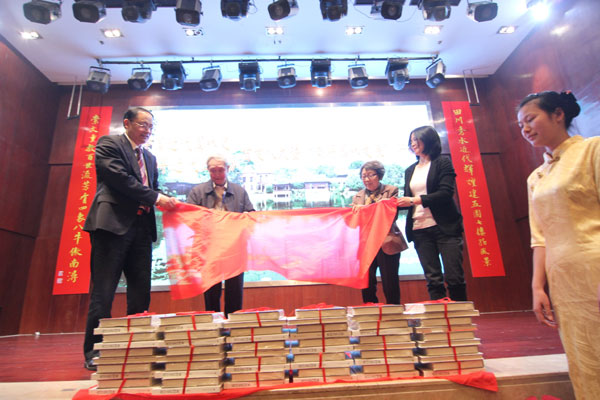Books on garden history issued in Nanxun
Updated: 2012-04-17 17:09
By Chen Qide (chinadaily.com.cn)
|
|||||||||||
SHANGHAI ---- Nanxun, a town of rivers and lakes in north of Zhejiang province, witnessed the issuance of China's first book on Chinese garden history in the modern times on Sunday.
The two-volume book introduces the country's garden history from 1840 to 1949 by listing 34 garden cases ranging from Taiwan in the east to Tibet in the west and from Heilongjiang in the north to Hainan Island in the south.
 |
|
Zhu Junzhen (2nd R), chief editor of the book on Chinese garden history in the modern times, unveils books at the book-awarding ceremony with Wang Lihui (R), editor-in-chief of China Construction Industry Publishing House, Wu Jiping (L), director of Nanxun District, and Gan Weilin (2nd L), former executive vice chairman of China Landscape and Garden Society. [Photo given to chinadaily.com.cn] |
"Its publication fills in gaps in books on China's garden history in the modern times," said Zhu Junzhen, chief editor of the book.
Modern gardens feature the traditional styles of royal gardens, private gardens and temple pavilions, but also absorb elements of Western parks facing the public, creating new-typed gardens with Chinese and Western styles. In addition, China also witnessed foreign-style gardens in the modern times, according to the book.
"All this shows that China's gardens underwent a continuous development in the modern times," said Zhu at the book-awarding ceremony.
The book-editing group consisting of more than 100 garden researchers from nationwide started to compile the book in 2004. They went to all corners of the country to collect historical materials.
The project was completed in 2010 with the book of more than 1 million words going to press. The book introduces garden cases collected from mainland provinces, Hong Kong, Macao and Taiwan, said Zhu, who is also professor of Architecture College Tsinghua University.
The first volume consists of seven chapters telling about the general situation of China's modern gardens, their features and styles, China's modern city parks, school gardens, villa gardens and celebrities' theories and practice on gardens.
Zhu said the second volume will analyse garden cases from nationwide by using materials from textual research.
"I first went to Nanxun when I edited the book in June 2010, finding that the town is a place which has so many gardens that it is worth to be compiled into another book as a supplement to the above book," she said.
The professor had been to Nanxun for seven times to make on-the-spot investigations since last June and meanwhile, investigated gardens in Suzhou, Wuzhen, Zhouzhuang, Tongli, Xitang and Shaoxing to collect materials for comparison, said Ye Lizhong, Party secretary of Nanxun District.
Finally, a book on Nanxun garden history came off the press in March 2012. It consists of six chapters to give an introduction on the ancient town and its garden development, make an analysis of Nanxun modern gardens, its stone layout and rockeries, and tell about the Chinese and Western styles of Nanxun gardens, and the influence of Nanxun culture on its gardens.
Nanxun, a town built in 1252 during the Southern Song Dynasty (1127-1279), has about 100 ancient grand courtyards, each surrounded by dwelling quarters, and 26 modern private gardens with five largest, each accounting for 1.5 hectares, ranking first among China's 20,000 towns, Zhu said.